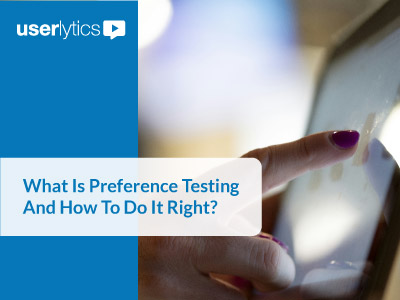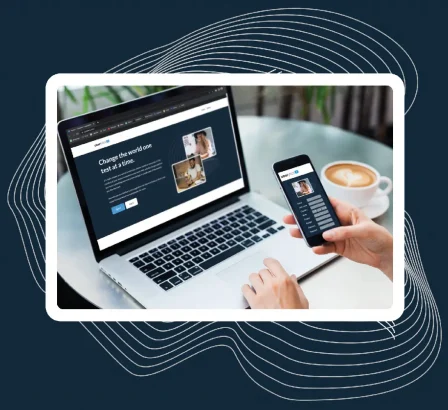
Quantitative User Testing vs Qualitative
As staples of nearly all research conducted today, many people think they know about the differences between qualitative (qual) and quantitative (quant) testing. However, in the context of user research, these two methodologies are often used interchangeably.
So, when to use one method or the other? In this article, we will look at both research methods individually and outline the best ways to use them. The information presented will be based strictly on the premise that UX testing is being conducted by a research team.
Understanding Qual and Quant
Before outlining the differences and characteristics of quantitative and qualitative testing, we need to understand what qualitative and quantitative research are -how they are defined and what their attributes are.
Quantitative Research

Quantitative Research can be easily defined as collecting and analyzing numerical data to drive insights from a study. It is the form of research we are most used to, as much of today’s teachings around research and data collection are based on quantitative output.
This form of research can be much easier to calculate and drive conclusions since quantitative data is often cut and dry. Analytical graphs, survey responses, and hard data metrics are the main staples of quant research.
Quantitative research comprises large sample sizes to ensure statistical validity and reliability. Researchers use statistical analysis methods to analyze the data, which may include descriptive statistics (e.g., means, frequencies, and percentages) and inferential statistics (e.g., correlation, regression, and hypothesis testing).
Quant is often used in market research studies as it allows for large data sets of participants at a reasonable cost. It is much quicker to analyze since it can be formed into visually appealing graphs that make it easy to share insights with business stakeholders.
There can be plenty of glaring quantitative data that should lead observers to one conclusion, but if that information is difficult to understand, then the power behind the insights is lost. In this regard, be extra careful to ensure that any quantitative data being shared is visualized in a way that non-department individuals can understand.
Qualitative Research

Qualitative Research, in comparison, is more difficult to visualize but is much more powerful in the conditions of a UX study. In remote user testing, considering the thoughts and feelings of your users falls under the category of Qualitative research.
Qual studies are normally conducted as moderated in-depth interviews. They allow researchers to probe deeper into the mind of the participant and ask follow-up questions to gain insights not possible in a quantitative study. Qual research can also be conducted in short-form unmoderated tests that are recorded. This is ideal in a remote testing situation where participants are participating via their desktop or mobile device.
There are many opportunities to conduct qualitative research in companies all over. It is often a missed practice due to the time required to conduct and increased overhead costs. But qual research does not have to be expensive.
At Userlytics, we allow for a quick turnaround on short-form unmoderated research studies. Simply set up a recruitment profile, create a study script that includes the asset link, then launch the project to the panel and wait about one day to get results back.
The beauty of unmoderated testing is that most feedback can be acquired with just 10 participants; additionally, the researcher can set up the study, and continue with other important work while waiting for participants to complete it!
Which Type of Methodology to Use and When
Before choosing which to use, it is important to understand what the goal of the research is. Below are a few examples of research practices with a look into where qual and quant fit within each.
Usability testing – identifying critical trends

The gold standard for asset testing, usability testing allows research teams to understand if users can easily use a website, app, or prototype concept -usability issues.
Qualitative research is most valuable in this scenario as it is vital to hear from the user why they do or do not feel the asset is usable. This is called qualitative usability testing.
That does not mean that quantitative research is not valuable in this scenario; for research teams that have no hypothesis for their asset, quantitative usability tests can allow them to run large data set quant studies to get an idea of where the problem areas are.
Once a trend begins to emerge, the research team can conduct qualitative user testing to understand what is really happening.
Journey mapping – depending on the research goals

Journey mapping is a research technique used to understand and visualize the experience of individuals as they interact with a product, service, or system over time.
It allows for identifying key touchpoints, pain points, and opportunities for improvement throughout the consumer journey. It’s an excellent study methodology that helps research teams understand the journey flow their users are taking.
When it comes to choosing the methodology for journey mapping, both qualitative and quantitative methods can be utilized, depending on the research goals and available resources.
Quantitative data will help the team note click paths and this can be easily visualized in heat maps. But again, qualitative information will ultimately tell researchers why users take a specific path to achieve a goal on the asset.
Market research – finding the perfect mix

Quantitative User Testing vs Qualitative
As mentioned above, quant is king when it comes to market research. This is because statistical significance comes into play more when trying to understand a target audience.
While this research is normally conducted by a marketing team, sometimes a UX research team will need to understand a broader audience better. Quant testing helps keep the overall cost of the project down since many participants are needed, and doing a large sample set on a Qual basis would be very expensive.
Once conclusions can be drawn from the data, in-depth interviews can be very valuable to cross-check the validity of the data and understand the deeper meaning behind the trends found.
Still, market research can utilize both qualitative and quantitative data, and the choice depends on the research objectives, the nature of the research questions, and the resources available.
Qualitative approach – focus on behavior
Qualitative testing is commonly used in market research to gain in-depth insights into consumer behavior, attitudes, preferences, and motivations. This approach is beneficial when the aim is to understand the “why” behind consumer decisions and to explore complex or nuanced aspects of the market. Qualitative methods are typically exploratory and provide rich, descriptive data.
Qualitative techniques that can be used in market research include:
- Focus groups: Bringing together a small group of participants to engage in interactive discussions, allowing for exploration of ideas, perceptions, and experiences.
- In-depth interviews: Conducting one-on-one interviews with individuals to delve deep into their thoughts, opinions, and experiences related to the market or product.
- Ethnographic research: Observing consumers in their natural environments to understand their behaviors and interactions with products or services.
- Online communities: Creating online forums or communities where participants can share their experiences, ideas, and opinions related to the market.
Qualitative research is valuable for generating insights, uncovering trends, identifying emerging themes, and developing hypotheses for further investigation. It provides a deep understanding of consumer needs, preferences, and behaviors, which can inform marketing strategies, product development, and positioning.
Quantitative approach – getting the most out of stats
Quantitative testing is used in market research to gather numerical data that can be analyzed statistically. This approach aims to measure, quantify, and generalize findings across a larger population. Quantitative research provides statistical validity, enables precise measurement, and supports hypothesis testing.
Quantitative techniques that can be used in market research include:
- Surveys: Administering structured questionnaires to a representative sample of the target market to collect data on preferences, purchasing behaviors, demographics, and other relevant variables.
- Online surveys and polls: Distributing online questionnaires to a broader audience to gather data on market trends, brand perceptions, customer satisfaction, and more.
- Experiments: Conducting controlled experiments to test specific hypotheses or evaluate the impact of marketing interventions on consumer behavior.
- Data analysis: Utilizing existing data sources, such as sales data, customer databases, or website analytics, to identify patterns, correlations, and trends.
In-depth interviews (IDIs) – building empathy
Quantitative User Testing vs Qualitative

Moderated testing is key to have in the arsenal of any UX research team. There is so much more a researcher can learn by speaking to a user rather than simply looking back at the results of a quant study.
When considering empathy in UX/UI design, interviews give researchers the opportunity to truly understand a user and build that empathy with how consumers experience an asset. Qual is the main methodology used here, but that does not mean quant can’t be used.
A research platform like Userlytics allows researchers to build quantitative concepts into their moderated sessions. Imagine being with a user in a remote interview and being able to conduct a card sorting exercise with them which is directly linked into the platform.
While card sorting can be considered a quant exercise, the researcher can still ask follow-up questions regarding why certain cards were placed into different categories to get qual feedback as well.
Quantitative User Testing vs Qualitative
Quantitative User Testing vs Qualitative
Conclusion – key takeaways
While there are many more types of research methods available in the broader spectrum of user experience, the list above should outline the main takeaway from this article. Qualitative and Quantitative research can be used individually, but achieve more when used in tandem.
Most research types will lean farther to one side in regards to qual and quant. But understanding how to mix in a touch of both is where researchers can really get the most out of the users in their studies.
Consider also that the stakeholders who will be making business decisions must be able to read and digest both your quantitative and qualitative data in a visual way.
An example of a complete UX report is one that has data displayed for quick digestion, but also includes a short video clip that backs up the recommendation of the research based on the data. Learn to harness the potential of Qualitative and Quantitative research by using both in separate and mixed situations.
If a researcher feels more comfortable using quant research, by learning and understanding the use case of qual, the research will unlock new insights not possible before!
Interested in UX Testing?
Data Visualizations
About the Author: Nate Brown

Nate is an accomplished account manager for many large enterprise-level companies in the North American region. With multiple years of experience collaborating with research teams to maximize their research in the Userlytics platform, Nate possesses key insights into why some research projects lack substance and others produce valuable insights. His favorite part about working at Userlytics is building lasting relationships with his clients, even in a remote setting.
Read More Articles by Nate



